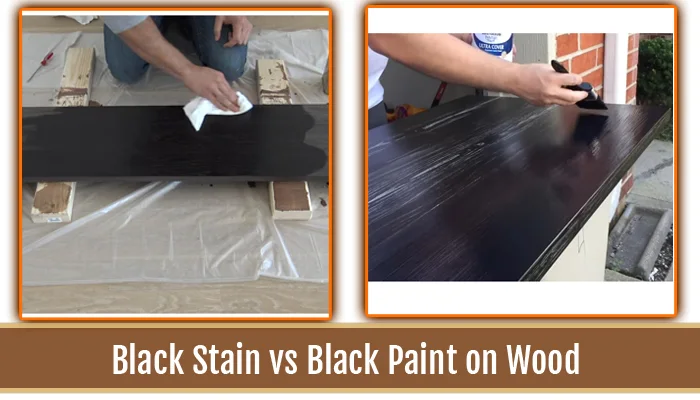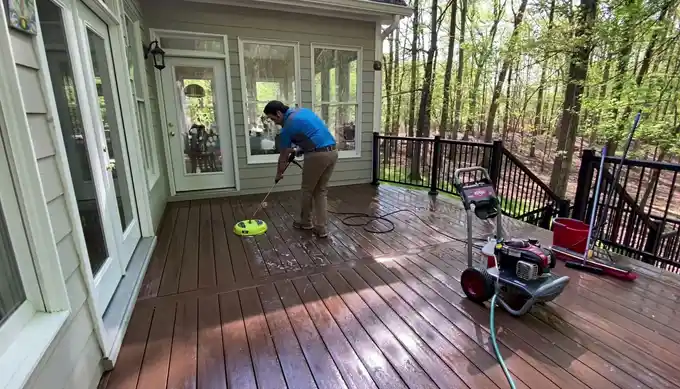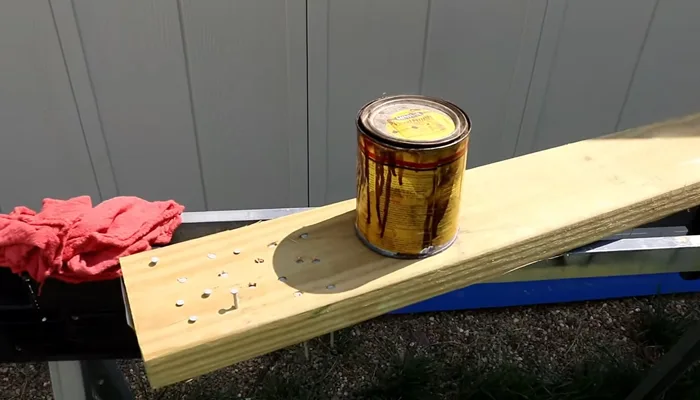WoodenuKnow.com is a participant in the Amazon Services LLC Associates Program, an affiliate advertising program designed to provide a means for sites to earn advertising fees by advertising and linking to Amazon.com and may earn from qualifying purchases.
When considering finishing options for wood, many debates between black stain vs black paint on wood. While both can provide a stunning aesthetic, some critical differences between the two should be considered before making a decision.
Paint is a thicker finish covering the grain of the wood beneath it. Stain, on the other hand, is thinner and allows the grain to show through. Paint can give wood a more uniform look, while stains can highlight the natural beauty of the wood grain.
But we are about to explore a few more things that we need to consider. Throughout this article, we will be discussing the key differences between black paint and black stain on wood to help you make an informed decision for your project.
When Should You Use Black Stains on Wood?
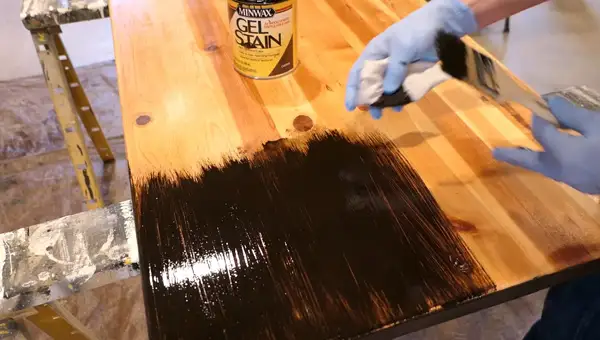
Black stain is perfect for giving wood a rich, dark finish. It is often used on mahogany and cherry furniture, as well as on floors and trim work. When choosing a black stain, it is important to consider the type of wood you are working with, as well as the desired final look. For floors and trim work, a semi-gloss or high-gloss finish will give the wood a deep, rich color.
For indoor and outdoor furniture, a less glossy finish will give it a more natural look. Black wood stain can also be used to create dramatic contrast in a piece of furniture or flooring. For example, you could use a black stain on a table’s legs to create a bold look. Whatever your project, the black stain can help you achieve the perfect look.
When Should You Use Black Paint on Wood?
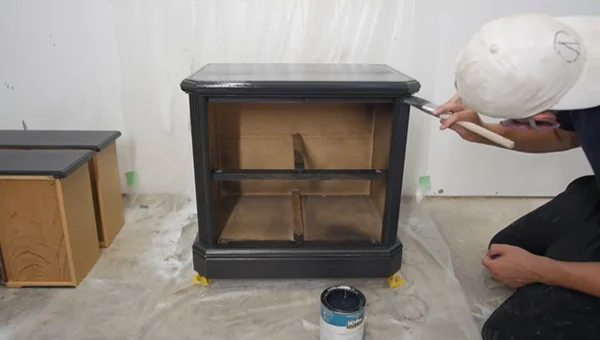
Black paint can be a beautiful way to finish wood, but it’s essential to know when and how to use it. In general, black paint is best used on wood that has been stained or otherwise finished. This provides a base for the paint to adhere to and prevents the wood from showing through the paint. Black paint can also be used to create a distressed look by sanding away some of the paint to reveal the underlying grain.
When using black paint on wood, it’s important to start with a clean wood glue joint surface. Any dirt, dust, or grease will show through the paint, so it’s essential to make sure the wood is clean before painting. Once the wood is clean, you can apply a layer of primer before painting with black paint. This will help ensure even coverage and prevent imperfections from showing through.
The Pros and Cons of Black Stain vs Black Paint on Wood
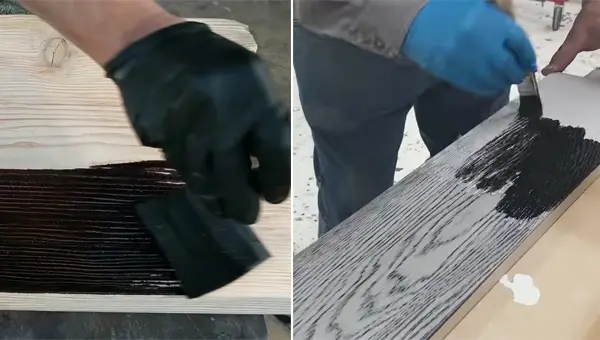
Here are some pros and cons of using black paint or black stain on wood:
Black Stain: Pros
First, let’s talk about the pros of black stain:
Hide Imperfections
When choosing a wood stain, many people opt for a dark color to hide imperfections in the wood. A dark stain can help to disguise scratches, dents, and other blemishes. Dark stains can also help to minimize the appearance of the wood grain. A dark stained wood or piece of furniture is often more polished and refined than its lighter-stained counterparts.
Dark stains are especially useful for hiding scratches and minor nicks. They can also help to disguise any discoloration that may have occurred due to sun damage or water stains. If the wood has different grain patterns or is of different colors, a dark stain can help to create a more cohesive look. For these reasons, many people choose dark stains for their wooden furniture.
Creates a Warmer Appearance
Black stain can give wood a rich, warm appearance that highlights the natural wood grain. It can also be used to create unique looks, such as a two-tone effect or an aged patina. Whether you’re looking for a classic black look or something more unique, the black stain is a great option for giving your wood surfaces a beautiful finish.
To get the most out of your black stain, follow the manufacturer’s instructions carefully and test the stain on a small area first to see how it will react with the wood. With a little care and effort, you can create stunning Results with a black stain that will add beauty and value to your home.
Black Stain Enhances Wood Grain
Black stain can be an excellent choice for accentuating the grain. The key is to apply the stain evenly and allow it to penetrate deeply into the wood. This will help to ensure that the grain is evenly saturated with color. The use of black stain can also produce a highly contrasting effect, which can be dramatic and eye-catching.
When used judiciously, the black stain can help to create a beautiful and unique work of art. For instance, the black stain can highlight the natural swirls and patterns in the grain. The contrast created by black stain helps to make the grain appear more pronounced. In short, the black stain can be a great way to accentuate the inherent beauty of the wood grain.
UV Rays and Environmental Factors
Wood is a beautiful and versatile material but also relatively fragile. Left unprotected, wood can be quickly damaged by UV rays, moisture, and other environmental factors. One way to help protect the wood from these threats is to apply a stain. A good stain will provide a barrier against moisture while still allowing the wood to breathe.
It will also help to block out UV rays, preventing the wood from fading or becoming brittle over time. A stain can help to camouflage any minor scratches or damage that has already been done. By taking these steps, you can help to ensure that your wood furniture or floors will continue to look their best for years to come.
More Affordable than Paint
When it comes to protecting wood against the elements, the black stain is a more affordable option than black paint. While paint creates a barrier on the surface of the wood, stain penetrates the wood’s pores, providing more excellent protection against water damage, rot, and mold. The stain is less likely to chip and peel over time, making it a more durable option for exterior surfaces.
When appropriately applied, the black stain can provide superior protection against the elements while also helping to improve the appearance of the wood. For these reasons, black stains are a cost-effective option than black paint for protecting wood against the elements.
Minimal Effort
Black stain is a type of wood stain that can be applied to create a natural, weathered look. It is relatively easy to apply and can be done with minimal effort. The main thing to remember when applying black stain is to work in small sections and to allow the stain to dry completely between coats. Black stain can also create a distressed look by adding additional coats in different areas.
When distressed, the black stain will lighten in those areas and give the wood a unique, antique appearance. Because it is easy to apply with minimal effort, the black stain is a suitable choice for those who want to achieve a natural, weathered look without spending a lot of time or money.
Black Stain: Cons
The next thing we will talk about is the cons of black staining:
Uneven Coverage
Achieving an even coverage with a black stain on wood can be difficult for several reasons. First, if the wood is not adequately prepared, the stain can simply sit on top of the wood and will not absorb evenly. Second, even if the wood is prepared correctly, the nature of the stain is such that an even finish may not be possible. Stain is typically applied with a brush or a rag, and it can be easy to miss spots or to apply too much in one area.
It is often necessary to go over the area several times to achieve even coverage. Finally, depending on the type of wood, the grain can absorb stain differently, resulting in an uneven appearance. For these reasons, it is often best to hire a professional when trying to achieve a smooth finish on the wood.
Darker Colors Show Dirt Faster
Black stains on wood tend to show dirt more easily than lighter colors for a few reasons. First, darker colors absorb more light, so any dirt or grime on the surface will be more visible. Second, darker colors create a higher contrast with the surrounding environment, making any imperfections more noticeable.
Finally, black is often associated with cleanliness, so any darker stain that forms will stand out against the expectation of a pristine finish. In short, while black stains may require more care to keep looking clean, the effort is usually worth it for the dramatic effect they can create.
Needs to be Sanded or Filled
Before applying a black stain to wood, it is essential to sand or fill the surface to create an even base. Uneven surfaces can cause the stain to pool or sit in areas, resulting in an uneven final finish. Any nicks or gouges in the wood will be more visible once stained, so filling them beforehand will help create a smoother look.
Once the surface is prepared, apply the stain evenly with a brush or rag, working in small sections at a time. Allow the stain to dry completely before applying a top coat of stain. With proper preparation, black staining can result in a beautiful, rich finish that enhances the wood’s natural grain.
Direct Sunlight Can Fade Black Stains
Black can be more susceptible to fading than other colors when exposed to direct sunlight. The reason for this is that black absorbs more light than other colors. This means that the energy from the sun’s rays is absorbed by the black pigment, causing it to break down over time. While this process is gradual, it can eventually lead to faded and dull-looking black stains.
For this reason, it is vital to protect black surfaces from direct sunlight whenever possible. This can be done by using awnings, shade cloths, or simply keeping them out of direct sunlight when possible. By taking these precautions, you can help ensure that your black surfaces will retain their original beauty for years to come.
Hard to Fix
Black can also be difficult to maintain. Even the slightest imperfection can be noticeable, and black stains can be difficult to touch up or repair if they become damaged. Black surfaces attract dust and fingerprints, making it challenging to keep them looking clean.
For these reasons, it is essential to take extra care when choosing black furniture or paint for your home. With a little effort, you can enjoy the elegance of black without worrying about constant upkeep.
Black Paint: Pros
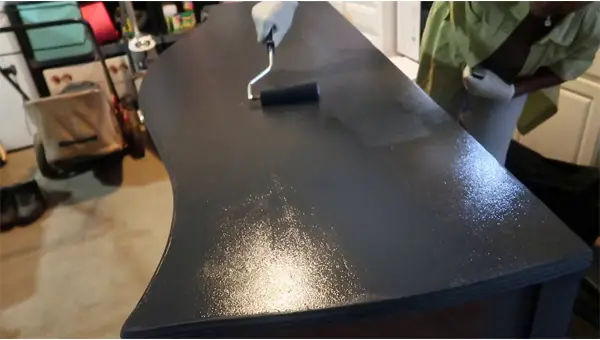
The benefits of black paint can be summarized as follows:
Dark Colors Mask Imperfections
As any woodworker knows, choosing the right stain for a project can be the difference between a beautiful finish and a disaster. Not only does the color of the stain impact the final look of the piece, but it can also affect how well any imperfections are hidden. For example, a dark stain is more likely to conceal minor scratches or dents than a light one.
This is because darker colors have a higher contrast with light, making it easier to see any blemishes. Darker colors absorb more light than lighter ones, which can help hide any minor scratches or dents. Choosing a dark stain for wood furniture can be an excellent way to help conceal any imperfections and keep the piece looking its best.
Looks Sleek and Sophisticated
Whether you’re looking to add a touch of glamor to your home or simply want to create a more sleek and sophisticated look, black spray paint is a great option. When used correctly, black paint can give any room a modern and stylish feel.
One of the great things about black paint is that it can be used in various ways. You can use it to create an accent wall, highlight architectural features, or even use it as trim for your doors and windows. Black paint is also very versatile when pairing it with other colors. For example, you could pair it with white for a classic look or use it as an accent color against brighter hues.
When choosing the right shade of black paint, there are a few things to keep in mind. First, consider the overall feel you’re trying to create in the space. If you want a more dramatic look, go for a darker shade of black. If you’re looking for something more subtle, opt for a lighter hue. And if you’re unsure which way to go, remember that you can always ask for help from a professional painter or designer.
Scratch Resistant
While black paint on wood can be more scratch resistant than other colors, there are a few factors to consider before choosing black paint for your woodworking project. One is the type of wood you’re using. Softer woods are more likely to show scratches, regardless of the paint color. The second is the type of finish you choose. A high-gloss finish will also show scratches more than a lower-gloss or matte finish.
Consider how the piece will be used. If it’s a heavily used area, like a tabletop or floor, you’ll want to choose harder-wearing paint. That said, black paint can be an excellent choice for scratch resistance in certain applications. It’s also worth noting that black paint can help to disguise scratches that do occur, making them less noticeable.
Mildew Resistant
Black is a very absorbent color, so it tends to soak up moisture more quickly than other colors. This can help to prevent Mildew from taking hold in the first place. Black paint also reflects light more efficiently than other colors, so it helps to keep the surface of the wood cooler. This can also discourage Mildew growth, as the fungus thrives in warm, damp environments.
It tends to be more durable than stain, so it is less likely to chip or flake over time. This can help to create a barrier that Mildew will have difficulty penetrating. Overall, black paint on wood provides superior protection against this damaging fungus.
Easy to Upkeep
Black paint is a classic color that can give any room a touch of sophistication. Though it is often seen as a high-maintenance color, black paint is pretty easy to upkeep with proper care. One of the benefits of black paint is that it is very forgiving.
Any imperfections in the surface will be less visible than with lighter colors. Black paint tends to last longer than other colors, so you won’t have to repaint as often. With just a little care, your black-painted surfaces will look great for years to come.
Black Paint: Cons
The following are some cons of black paint that you should be aware of:
Easy to Spot Dirt
It’s important to be aware that the color can magnify imperfections in the underlying surface. Even a tiny amount of dust or debris will be highly visible on black paint. And any imperfections in the wood itself will be more apparent with black paint due to the high contrast between the dark color and the light wood.
If you’re planning to paint furniture black, it’s essential to start with a smooth, pristine surface. The dark paint will magnify any flaws, so it’s worth taking the time to sand and prime the surface before painting. With a bit of extra care, you can achieve a stunning finish that will show off your woodwork beautifully.
Absorbs Heat
Black paint on wood can absorb heat, making the surfaces hotter to the touch. This can be a problem in areas that receive a lot of sunlight, as the heat can make the surface uncomfortable to walk on or put your hand on. The heat absorbed by the black paint can cause the wood to warp over time.
While this may not be a problem with small objects, it can be an issue with more oversized items such as painting furniture. The warped shape can make the piece uncomfortable to use and diminish its aesthetic value. To avoid these problems, it is best to use lighter colors on surfaces that will be exposed to direct sunlight.
Requires More Frequent Cleaning
Black paint on wood can require more frequent cleaning for several reasons. For one, it shows fingerprints and smudges more quickly than lighter colors. This is because the darker color provides a contrast that makes them stand out. Secondly, black surfaces tend to attract dust and other particulates. These can build up over time and make the surface look dull.
Regular cleaning can help to keep the surface looking clean and shiny. It is essential to avoid using harsh cleansers or scrubbing too vigorously, as this can damage the paint. With a little care and attention, a black painted surface can stay looking good for many years.
Black Painted Furniture Looks Heavy
For several reasons, black paint can give the furniture a heavy and dated look. First, black is a very saturated color, so it tends to absorb light rather than reflect it. This can make a room feel smaller and more cramped, which is why many designers recommend using black sparingly. Black can be a very formal color, so it’s not always appropriate for casual or contemporary spaces.
Because black paint tends to show every imperfection, it’s essential to use high-quality paint that will flow smoothly and evenly. Otherwise, you may end up with an uneven finish that looks lumpy and unfinished. For all these reasons, it’s important to consider the drawbacks of black paint before you decide to use it in your home.
Accessorizing Black Furniture
BLACK always looks elegant and sophisticated in any setting. When it comes to furniture, black can be tricky to work with. One of the biggest challenges is finding accessories that coordinate with black furniture. Because black is such a dark color, it can be challenging to find throws, pillows, and rugs that complement it without looking too heavy or overwhelming.
Black paint can be notoriously difficult to match if you ever need to touch up your furniture or make repairs. Many people choose to avoid black furniture altogether. If you’re willing to put in the extra effort, black furniture can add a touch of sophistication and elegance to your home.
Which One Should You Choose for Your Project?

Stain is generally easier to apply than paint, and it can provide a more natural look. It can be challenging to achieve even coverage with stain, and it may not provide as much protection as paint. Paint is more durable than stain and provides better protection against wear and tear. It can be tricky to get a smooth finish with paint, and it may require multiple coats.
So, which one should you choose? It depends on your preferences and the overall look you are going for. If you want a more uniform look, go with paint. If you want a more natural look, go with gel stain. Just keep in mind that you will need to reapply stains more often than paint. If you’re not sure which one to use, consult with a professional before beginning your project.
FAQs
What wood looks best stained black?
Many types of wood can be stained black, each with its unique grain and color. Some of the most popular options include mahogany, maple, oak, and walnut. All these woods are relatively hard and durable, making them ideal for furniture and flooring. Each type of wood also takes stains differently. so it’s vital to experiment with a few samples before making a final decision.
Mahogany and walnut produce a deep, rich color when stained black, while maple and oak tend to take on a more muted hue. Ultimately, the best wood for staining black depends on your tastes and what you’re trying to achieve.
Does black stain fade?
Just as with any other type of stain, the amount of time that a black stain will last will depend on several factors. The darkness of the stain, the type of material it is applied to, and the amount of exposure to sunlight and other elements will all play a role in how long the stain will last.
Darker color stains will last longer than lighter ones. This is because darker colors absorb more light, making them less susceptible to fading. Black stains also tend to penetrate deeper into the material, making them harder to remove. If you are looking for a stain that will last for a more extended time, you should choose a dark color.
Does wood stain last longer than paint?
When it comes to durability, paint typically does a better job of lasting longer than stain. Stain is generally less expensive and takes less time to apply, but it doesn’t provide the same level of protection as paint. Paint is more rot resistant and does a better job of preventing mold and sun damage. If you’re looking for the best coverage, painting is usually the way to go. There are some benefits to stains that shouldn’t be ignored.
Stain penetrates deep into the wood, providing better protection against water damage. Stain also allows the grain of the wood to show through, giving your project a more natural look. Ultimately, the best choice depends on your specific needs. If you’re looking for maximum protection, paint is the way to go. But if you’re trying to achieve a specific look or working with a tight budget, a stain may be the better option.
How do you protect black paint from wood?
When it comes to protecting black paint from wood, there are a few things you can do to ensure longevity. First, it’s essential to make sure the paint is sealed correctly. This will help to prevent moisture and dirt from seeping in and causing damage. You can also apply a clear topcoat to the paint, adding an extra layer of protection.
It’s important to keep the area clean and free of debris. Regular dusting and vacuuming will help to extend the life of your black paint job. By taking these simple steps, you can ensure that your paint job looks great for years to come.
Last Words
As we discussed earlier, there are pros and cons when it comes to black stain vs black paint on wood. Black stain can provide a beautiful, natural look to wood, while black paint can give a more uniform appearance. Ultimately, the best choice for your woodworking project will depend on your personal preferences and the amount of time and effort you’re willing to put into it.
If you’re looking for a quick and easy solution, black paint is ideal. But if you’re willing to take the time to apply and seal the stain correctly, you’ll be rewarded with a stunning, one-of-a-kind project that will last for years. We hope you enjoyed this article. If you have any questions or comments, please feel free to reach out to us. Thanks for reading.

